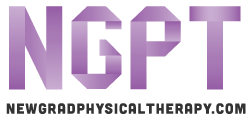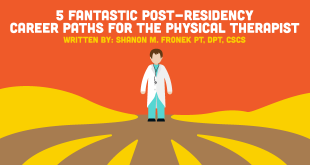What You Need to Know:
-
The goal of your student physical therapy resume is to show, not tell, why the employer should invest their time, money, and trust in you.
-
Employers are looking for therapists who can add value ($$) to the bottom line – both in the short term and long term, and either directly or indirectly.
-
You can use your time in school to create and develop the qualities, skills, and experiences necessary for building an effective resume.
-
This will give you leverage when applying for jobs, negotiating a salary, and discussing benefits.
Building an Awesome Physical Therapy Resume
The idea of strategically building a physical therapy resume can, at first, seem insincere and contrived. But stay with me; this process is different than simply jumping from opportunity to opportunity for the sake of adding more material to a resume. While this may lead to an impressive list of accomplishments, it does not highlight what you took away from the experience, and does not give a strong indication of what your performance might look like if you were hired. Instead, building an effective resume is about considering the necessary qualities and skills that make for a good clinician, business partner, and leader, and then seeking out experiences in order to develop these qualities. This way, you can build a physical therapy resume which reflects the characteristics and skills desired by employers, and is backed by concrete evidence and experience.
Clinical Experience
You need experience to get a job, but you need a job in order to get experience. This seems paradoxical, but luckily we can get around this catch-22 through our clinical affiliations. This is the only real physical therapy experience you will have had up to this point, so it is important to make the most out of it, and think ahead as to what values, skills, and experiences will be transferable to your first job. This is not limited to, but certainly includes, clinical decision making, corrective exercise, and psychomotor abilities like manual therapy. While these are extremely important, and you should be asking your CI for lots of feedback, they are also expected as a minimum when applying for jobs. To make this section of your resume really stand out, don’t forget to focus on networking with different types of health providers, learning about how to run a clinic, communicating with and treating a diverse population, and giving examples of your productivity.
Your experience in your clinical affiliations is the most important part of building your resume, but there are still some additional steps to take that can indirectly bulk up your resume, enhancing your future job performance. The more comfortable you feel with patients, the less time your employer has to worry about a transition period when you graduate, which means less money and time required to invest in you. To build this comfort in patient interaction, you can contact local clinics and ask to come in and observe, and look for clinics offering aide positions. This will give you additional time interacting with both patients and therapists. Similarly, you can also find work as a personal trainer, strength coach, or athletic trainer. While not exactly physical therapy, there is a HUGE overlap between designing and implementing a strength and conditioning program with a physical therapy program.
Passion for Personal and Professional Growth and Development
How invested are you in your profession? Though not a perfect correlation, a clinician who is constantly looking to improve and has a growth mindset will probably also bring a lot of value to the clinic. Again, the employer is looking to add to the bottom line, and your passion for growth will indirectly contribute through your skills and attitude. This is where you can build your resume by signing for seminars, continuing education courses, and leadership positions. Leadership positions can also include getting involved with the various advocacy and interest groups in the APTA. This demonstrates that you are not only looking to improve yourself, but the organization as a whole.
Proactive Behavior
Being proactive, as opposed to reactive, is about self-initiated behavior, anticipating future needs, and taking control of situations instead of adjusting to them. Proactive therapists are more likely to go beyond the level of proficiency, will take action before being asked to do so, and require less instruction. So, if you can demonstrate proactive behavior through your resume, you are more likely to get an invitation for an interview. Steps which can be taken while in school aren’t limited to any particular domain. As mentioned earlier, starting a language class highlights your ability to see a need that was not currently met, and by recognizing that you had the available skills, you took steps on your own to provide a solution. Another example could be looking ahead to what niche you want to fit into within the broad scope of physical therapy. If you see yourself going down the sports or orthopedic route, you can study for and get your CSCS certification before graduating. This not only demonstrates your proactive attitude to your potential employer, but is also added value which you could bring to the clinic. Think of ways you could be improving yourself or others, and then use your proactive attitude to create a solution.
Professional Interdependence
It is expected that you will be able to manage yourself and work on your own, but employers are also hoping that you are able to work well with others. This is an essential component of teamwork, because it highlights your ability to provide unique skills, while also complementing the skills of others. This means a better working environment, more productivity, and a unified office culture. The best way to build this aspect of your resume is to get involved with projects requiring group collaboration. This can include working as a research assistant, which will also give you research experience; starting an organization at school, perhaps an inter-professional networking group; or a taking on a leadership role within your class.
Community Interaction and Marketability
Another way to bring indirect value to a clinic is through marketing and community interaction. If an employer sees that you have the potential to not only bring valuable clinical skills, but also the ability to help bring in new patients, your resume will certainly get a closer inspection. Use your time in school to build this section of your physical therapy resume by doing local volunteer work in your community, such as health screenings, or setting up booths at local sporting events. You can also learn the basics of search engine optimization, and branding/social media design.
Reliable References
Ok, so you have developed the skills and qualities that employers would go crazy for, but don’t forget that you will need a few reputable and reliable people who have your back. Now is the time to build and solidify relationships with these people. These can be your former CI, your professor, a PI of a research project, a therapist you have worked under, or a former mentor. Make sure they are aware of what you contributed, and possibly what else you have been involved with while in PT school, so when the time comes, they can give concrete examples of how you will bring value to the job.
Conclusion
It is unlikely that even the best physical therapy resume itself will land you a job. However it is a crucial entry point, and is essential for securing an interview. Your potential employer’s decision will ultimately come down to a single question, and that is whether you will help the clinic make money. There are many factors that come into play here, both direct and indirect, which can be built while you are still in school, and highlighted in your resume.
Are you building your resume through any unique opportunities? Share your thoughts in the comments section!
 NewGradPhysicalTherapy.com The Largest Online Resource For New Grad Physical Therapists
NewGradPhysicalTherapy.com The Largest Online Resource For New Grad Physical Therapists






